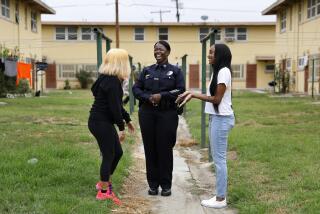Services Under Fire for Keeping Women Out of Combat Jobs
WASHINGTON — Visiting Soviet Marshal Sergei Akhromeyev had a problem. He wanted to thank the Navy pilots who had flown him to and from the aircraft carrier Roosevelt, and one of them was a young woman.
Akhromeyev crisply returned the salute of Lt. Cmdr. John Labella, then faced Lt. Christine Lipphardt. She also stood at attention and saluted.
“He didn’t know what to do,” recalled Akhromeyev’s host and American counterpart, Adm. William J. Crowe, then chairman of the Joint Chiefs of Staff. It was clear, Crowe said, that the man who commanded millions of Soviet soldiers couldn’t decide whether military discipline or his social conditioning should prevail.
“Finally, he grabbed her hand and kissed it,” Crowe recalled with a chuckle. “And then she got confused!”
The admiral, now retired, likes to recount that 1988 incident to show the advancements women have made in the American military services.
As demonstrated by Army Capt. Linda Bray’s command of a military police unit during the Panama invasion last December, women over the last 10 years have slowly assumed many jobs that place them in harm’s way.
Bray, riding in an armored Jeep under fire, directed troops of the 988th Military Police Company in an assault on a Panamanian Defense Forces canine unit barracks. (Initial news reports said three Panamanians were killed in the skirmish, but the Army said later that no bodies were found.)
“Shots were fired. I returned fire. And that’s the way it was,” Bray said later.
One who argues that women should be allowed to go into combat is retired Brig. Gen. Evelyn Foote, who joined up when women were relegated to the Women’s Army Corps to serve primarily as nurses or secretaries.
“When the shooting starts, it’s a moot issue,” said Foote, whose career spanned 29 years in posts from Vietnam to Europe. “The nature of the modern battlefield means that there are no front lines, no flank, no rear. . . . If women are serving, they will be in combat.”
Others remain skeptical.
“The simple truth is this: However well one woman (or 1,000 women) may have performed in a firefight in Panama, it does not change the fact that men--as a group--fight better than women,” Lou Marano, a Vietnam vet and a Washington Post editor, asserted in a recent commentary.
The Women’s Armed Services Integration Act of 1948 prohibits the Navy, the Air Force or Marine Corps from assigning women to duty on “vessels or in aircraft that are engaged in combat missions.”
By policy, the Army bars women from participating in its primary fighting elements--infantry, tank and most artillery units--but they do serve in many of the supply or support units that could end up in the thick of battle.
The legal restrictions against women in combat do not include the Coast Guard, which is under the Department of Transportation in peacetime, but it is unclear whether women in Coast Guard command positions would retain their posts should the Coast Guard be integrated into the Navy in time of war.
As pressure has grown to open more military jobs to women, the definition of combat has changed. In 1988, Pentagon officials devised the “risk rule” to determine what chance of being in combat, encountering hostile fire or being captured any unit faces.
Because the services have some leeway over which jobs are open to women, some restrictions have fallen by the wayside and debate rages over others.
At the end of 1989, 229,000 women were in the Army, Navy, Air Force and Marines, representing about 11% of military personnel. The Coast Guard had 2,700 women, or 7.3%.
The number of women in the military has risen dramatically since 1967, when President Johnson lifted a 2% maximum rule. He also ended a ban on women as generals or admirals.
With the introduction of the all-volunteer force in 1973, the military began to recruit women to fill its ranks.
A recent study by RAND Corp. found that one of eight new recruits is female. And more women want to volunteer than are accepted, the study said.
Although most women still go into administrative, clerical, medical, communications or intelligence specialties, they are being integrated more and more into male-dominated jobs. They are being graduated from the service academies and slogging through basic training with their male colleagues.
Side by side with men, women control the keys to nuclear launching equipment in the Air Force’s underground missile silos.
They’ve served aboard ships in the Persian Gulf, repairing and refurbishing ships damaged by enemy missiles.
They tote M-16 rifles on guard duty at bases from Okinawa to West Germany, and stand ready to ferry supplies to troops should war break out again in the demilitarized zone between Communist North Korea and capitalist South Korea.
In Panama, women flew Strategic Air Command transports that refueled planes carrying troops and supplies from the United States.
They dodged bullets and artillery fire while flying troops to battle aboard Blackhawk helicopters--two of the pilots were the first women to be nominated for the prestigious Air Medal with a bronze V for valor.
For all these advances, the confusion that struck the five-star Soviet general when he faced Lt. Lipphardt seems also to afflict many male leaders in this country as well, when it comes to the idea of women as warriors.
There is no doubt in Lipphardt’s mind. She flies planes to and from aircraft carriers with mail, people and supplies, but she can’t be based on a warship as a jet pilot because that would be combat duty.
Now, without a chance to go after what she considers the Navy’s most challenging job, she is thinking of leaving the service.
“If the ban against combat flying were dropped, maybe I’d feel differently,” she said.
Last fall, the Pentagon’s Defense Advisory Committee on Women in the Services reported to Defense Secretary Dick Cheney that the services “can ill afford to continue to limit these women and their experiences in the face of the anticipated manpower shortages of the 1990s.”
Based on statistics alone, women seem to fare best in the Air Force, where long-distance weaponry allows 97% of its specialties to be open to women; 13.6% of the Air Force is female.
Women are barred from fighters, bombers, tactical airlift transports and some helicopters, but they are allowed to fly in some cargo planes, in command-post aircraft, on reconnaissance aircraft and on support missions.
The Air Force recently lifted restrictions against women flying on the transports that drop paratroopers into battle zones.
The Army is 11.4% female, and its recruitment advertising boasts that more than 93% of its specialties are open to women. Given the service’s combat needs, however, this means that about half of all Army jobs are closed to women.
The Army, after more than a year of indecision, still doesn’t know what to do with about 345 women trained as field artillery officers who were pulled from their jobs amid objections that they would be too exposed to enemy fire.
The Navy, which is 9.9% female, bars women from serving on all aircraft carriers except the Lexington, a training ship. Other combat vessels, such as destroyers and cruisers, are also off limits, but women do serve at sea on support ships, such as oilers and tenders, that supply carriers, submarines and other fighting vessels.
In the Marines, just 4.8% of jobs are open to women. Officials noted that because the corps relies on the Navy for medical services, it has relatively few nursing jobs.
Questions about the future of women in the military have grown sharper, not only because of the attention focused on the hundreds of women who participated in the Panama invasion, but also because of the massive personnel cuts that lie ahead as the Cold War winds down.
Two congresswomen say they want to ensure that military women don’t suffer disproportionately in reductions of forces that seem certain to come with the easing of East-West tensions.
Rep. Patricia Schroeder (D-Colo.), a member of the House Armed Services Committee, has introduced legislation to allow women to go into combat, at least on a trial basis. Her bill would allow women in the Army to apply for all positions, including combat-related ones. After four years, the women’s performance would be evaluated to see if the program should be continued.
“Polls show 7 out of 10 Americans think women should have a chance to serve in combat units if they want to,” Schroeder said. “It’s a really touchy issue . . . but we’ve had women die in combat, and I think the American people are aware of what that means.”
Rep. Beverly B. Byron (D-Md.), chairman of the House Armed Services subcommittee on military personnel, agrees that more job categories should be open to women but opposes their entering combat units.
“We’re moving along at a pace I’m comfortable with,” she said.
West Point and the Navy and Air Force academies began graduating women only 10 years ago, so few female officers have had time to reach the higher, decision-making ranks.
At the end of last year, just seven women held the rank of general or admiral.
“We’re still in the process of aging the officer corps,” Gen. Foote said. “It’s going to take us a while to get women where they can make more than just token changes in the way the military is run.”
Total Number of Women in the Military
Active-duty forces Sept. 1989 figures
Officers Enlisted Army 11,746/12.8% 74,232/11.2% Navy 7,449/10.7% 49,640/9.7% Air Force 13,403/12.9% 63,175/13.5% Marines 622/3.4% 9,044/4.9% Coast Guard 250/4.9% 2,448/7.3%
Source: Department of Defense and U.S. Coast Guard Headquarters
Women Officers in the Military Female officers as a percentage of the total: Five-star general or admiral Total: o Female: 0 0% Four-star general or admiral Total: 39 Female: 0 0% Three-star lieutenant or vice admiral Total: 123 Female: 0 0% Two-star major general or rear admiral Total: 383 Female: 0 0% One-star brigadler general or rear admiral Total: 551 Female: 7 1.3% Colonel or captain Total: 14,450 Female: 365 2.5% Lieutenant colonel or commander Total: 33,126 Female: 1,764 5.3% Major or lieutenant commander Total: 54,686 Female: 5,458 10.0% Captain or lieutenant Total: 107,986 Female: 14,118 13.1% 1st Lieutenant or lieutenant junior grade Total: 42,825 Female: 6,518 15.2% 2nd lieutenant or ensign Total: 34,461 Female: 5,240 15.2% Active-duty officers in Sept. 1989 Totals include the Army, Navy, Air Force, Marine and Coast Guard
More to Read
Sign up for Essential California
The most important California stories and recommendations in your inbox every morning.
You may occasionally receive promotional content from the Los Angeles Times.










